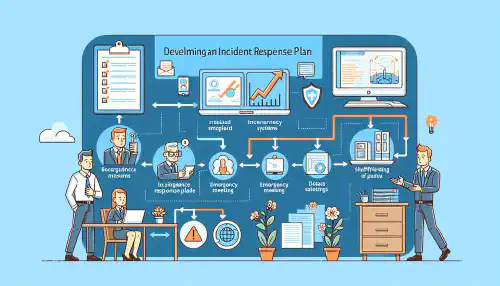Mastering Cybersecurity: A Proactive Guide to Effective Incident Response Planning

Table of Contents
Incident Response Planning: A Step-by-Step Guide for Businesses
Incident response planning is a critical process for businesses to effectively handle and mitigate security incidents. By having a well-defined incident response plan in place, organizations can minimize the impact of incidents, reduce downtime, and protect sensitive data. This step-by-step guide will walk you through the key components of incident response planning, the importance of creating an incident response team, developing an incident response plan, testing and refining the plan, and implementing the right tools and technologies.
Key Takeaways
- Incident response planning is essential for businesses to effectively handle security incidents.
- Creating an incident response team with the right skills and expertise is crucial.
- Developing a comprehensive incident response plan involves identifying potential threats, defining response procedures, and documenting step-by-step processes.
- Regular testing and refining of the incident response plan is necessary to ensure its effectiveness.
- Implementing the right incident response tools and technologies can enhance incident detection and response capabilities.
Understanding Incident Response Planning
What is incident response planning?
Incident response planning is a crucial aspect of cybersecurity strategy for businesses. It involves developing a comprehensive plan to effectively respond to and mitigate security incidents. The goal of incident response planning is to minimize the impact of incidents, restore normal operations, and prevent future occurrences.
Key elements of incident response planning:
- Preparation: This involves identifying potential threats and vulnerabilities, conducting risk assessments, and establishing incident response procedures.
- Detection and analysis: Prompt detection and analysis of security incidents are essential for effective response. This includes monitoring systems, analyzing logs, and investigating potential indicators of compromise.
- Containment and eradication: Once an incident is detected, it is crucial to contain the impact and eradicate the root cause. This may involve isolating affected systems, removing malware, and patching vulnerabilities.
- Recovery and restoration: After containing the incident, the focus shifts to recovering affected systems and restoring normal operations. This includes restoring data from backups, implementing security enhancements, and conducting post-incident reviews.
- Lessons learned and improvement: Incident response planning also involves learning from past incidents and continuously improving the response process. This includes analyzing incident data, identifying areas for improvement, and updating the incident response plan accordingly.
Why is incident response planning important for businesses?
As a cybersecurity expert, I cannot stress enough the importance of incident response planning for businesses. In today’s digital landscape, cyber threats are becoming more sophisticated and prevalent, making it crucial for organizations to be prepared for potential security incidents. Incident response planning allows businesses to effectively and efficiently respond to and mitigate the impact of security breaches, minimizing financial losses, reputational damage, and legal consequences.
Here are some key reasons why incident response planning is vital:
- Timely response: A well-defined incident response plan enables businesses to respond promptly to security incidents, reducing the time it takes to detect, contain, and remediate the breach.
- Minimize damage: By having a plan in place, organizations can minimize the damage caused by security incidents, preventing further compromise of sensitive data and systems.
- Preserve business continuity: Incident response planning ensures that critical business operations can continue during and after a security incident, minimizing disruptions and downtime.
- Compliance requirements: Many industries have regulatory requirements for incident response planning. Implementing a robust plan helps businesses meet these compliance obligations.
In summary, incident response planning is a proactive approach that helps businesses effectively respond to and recover from security incidents. By investing in a comprehensive incident response plan, organizations can safeguard their assets, maintain customer trust, and mitigate the potential financial and reputational impact of cyber threats.
Key components of an effective incident response plan
An effective incident response plan should include several key components that ensure a comprehensive and efficient response to security incidents. These components are crucial for minimizing the impact of incidents and restoring normal operations as quickly as possible.
1. Incident Classification: Classifying incidents based on severity levels helps prioritize response efforts and allocate resources effectively. By categorizing incidents into different levels, organizations can determine the appropriate response actions and escalation procedures.
2. Incident Response Roles and Responsibilities: Clearly defining the roles and responsibilities of each team member involved in the incident response process is essential. This ensures that everyone understands their specific tasks and can collaborate effectively during an incident.
3. Communication and Reporting: Establishing clear communication channels within the incident response team and with other stakeholders is vital. Timely and accurate communication enables efficient coordination, information sharing, and decision-making throughout the incident response process.
4. Incident Detection and Analysis: Implementing robust incident detection mechanisms allows organizations to identify and respond to incidents promptly. This includes leveraging security tools, monitoring systems, and threat intelligence to detect and analyze potential security breaches or anomalies.
5. Incident Containment and Eradication: Once an incident is detected, it is crucial to contain and eradicate the threat to prevent further damage. This involves isolating affected systems, removing malicious code, and restoring the integrity of compromised assets.
6. Evidence Collection and Preservation: Properly collecting and preserving evidence is essential for conducting a thorough investigation and potential legal proceedings. Organizations should follow established procedures to ensure the integrity and admissibility of evidence.
7. Incident Recovery and Lessons Learned: After resolving an incident, organizations should focus on recovering affected systems and services. Additionally, conducting a post-incident analysis helps identify areas for improvement and enables organizations to refine their incident response plan for future incidents.
Creating an Incident Response Team

Roles and responsibilities of the incident response team
The incident response team plays a crucial role in handling and mitigating security incidents. They are responsible for coordinating the response efforts and ensuring a thorough action plan for security issues. The team members should have a clear understanding of their roles and responsibilities to effectively respond to incidents. Here are some key responsibilities of the incident response team:
- Identifying and assessing security incidents: The team should be able to quickly identify and assess the severity of security incidents. This includes analyzing the impact and potential risks associated with the incident.
- Containment and eradication: Once an incident is identified, the team should take immediate action to contain and eradicate the threat. This may involve isolating affected systems, removing malicious software, or blocking unauthorized access.
- Forensic investigation: The incident response team should conduct thorough forensic investigations to determine the root cause of the incident. This involves analyzing logs, examining system configurations, and gathering evidence.
- Communication and reporting: Effective communication is essential during incident response. The team should establish clear communication channels and keep stakeholders informed about the incident, its impact, and the progress of the response efforts.
- Documentation and lessons learned: After the incident is resolved, the team should document the incident response process and any lessons learned. This documentation can be used to improve future incident response efforts and enhance the overall security posture of the organization.
Selecting team members with the right skills and expertise
When it comes to selecting team members for an incident response team, it is crucial to identify the roles and responsibilities that each individual will fulfill. This ensures that the team is well-rounded and capable of effectively responding to incidents. By clearly defining the roles, the team can work together seamlessly, leveraging each member’s unique skills and expertise.
Establishing communication channels within the team
Effective communication is crucial for the success of an incident response team. It ensures that all team members are well-informed and can collaborate efficiently during an incident. Designated incident response team members should have clear channels of communication established to facilitate quick and accurate information sharing. This helps in coordinating response efforts and making timely decisions. Communication channels can include various methods such as email, instant messaging, and dedicated communication platforms. It is important to ensure that these channels are secure and accessible to all team members.
Developing an Incident Response Plan

Identifying potential threats and vulnerabilities
Identifying potential threats and vulnerabilities is a crucial step in developing an effective incident response plan. By understanding the specific risks that a business may face, cybersecurity experts can tailor their response strategies to mitigate these threats. Threats refer to any potential events or actions that can cause harm to the organization’s information systems, while vulnerabilities are weaknesses or flaws in the system that can be exploited by attackers.
To identify potential threats and vulnerabilities, cybersecurity experts employ various techniques and methodologies. These may include:
- Risk assessments: Conducting comprehensive assessments to identify and evaluate potential risks to the organization’s information systems.
- Penetration testing: Simulating real-world attacks to identify vulnerabilities and weaknesses in the system.
- Security audits: Reviewing the organization’s security controls and practices to identify any gaps or weaknesses.
Once potential threats and vulnerabilities are identified, they can be categorized based on their severity and likelihood of occurrence. This categorization helps prioritize the response efforts and allocate resources effectively. By understanding the specific threats and vulnerabilities that a business may face, cybersecurity experts can develop targeted response procedures and ensure that the incident response plan addresses the most critical risks.
It is important to note that the identification of potential threats and vulnerabilities is an ongoing process. As technology evolves and new threats emerge, businesses must regularly reassess their risks and update their incident response plans accordingly.
Defining incident severity levels and response procedures
Defining incident severity levels and response procedures is a crucial step in developing an effective incident response plan. By clearly defining the severity levels, organizations can prioritize their response efforts and allocate resources accordingly. It also helps in determining the appropriate actions to be taken based on the severity of the incident. Response procedures outline the step-by-step processes that need to be followed during an incident. These procedures ensure a consistent and structured approach to incident response, minimizing the risk of errors or omissions. They provide guidance to the incident response team on how to contain and eradicate computer incidents .
Documenting step-by-step incident response processes
Documenting step-by-step incident response processes is a crucial aspect of developing an effective incident response plan. By clearly outlining the specific actions and procedures to be followed during an incident, organizations can ensure a coordinated and efficient response . This documentation serves as a reference guide for the incident response team, enabling them to quickly and accurately respond to security incidents. It also helps in maintaining consistency and ensuring that all team members are on the same page when it comes to incident response.
Testing and Refining the Incident Response Plan

Conducting tabletop exercises to simulate incidents
Conducting tabletop exercises is a crucial step in incident response planning. These exercises involve simulating various cybersecurity incidents to test the effectiveness of the incident response plan and identify any gaps or weaknesses. By conducting these exercises, organizations can evaluate their preparedness and improve their incident response capabilities. Tabletop exercises provide a controlled environment to practice and refine incident response procedures, allowing the incident response team to familiarize themselves with the steps involved in detecting and analyzing cybersecurity incidents .
Analyzing and learning from past incidents
Analyzing and learning from past incidents is a crucial aspect of incident response planning. By examining previous security breaches and cyber attacks, businesses can gain valuable insights into their vulnerabilities and weaknesses. This analysis helps organizations identify patterns, trends, and common attack vectors, enabling them to develop more effective incident response strategies . It also allows businesses to understand the impact of different types of incidents and prioritize their response efforts accordingly.
Continuous improvement and updating of the plan
Continuous improvement and updating of the incident response plan is crucial for maintaining its effectiveness and ensuring the organization’s ability to respond to evolving cyber threats. This process involves regular evaluation and refinement of the plan based on lessons learned from past incidents and changes in the threat landscape.
To facilitate continuous improvement, organizations should consider the following:
Regular review and assessment: Conduct periodic reviews of the incident response plan to identify any gaps or areas for improvement. This can be done through internal audits or external assessments by cybersecurity experts.
Incident post-mortems: After each incident, conduct a thorough analysis to identify the root cause, evaluate the effectiveness of the response, and identify areas for improvement. Document these findings and incorporate them into future iterations of the plan.
Training and awareness programs: Provide ongoing training and awareness programs to ensure that all members of the incident response team are equipped with the necessary knowledge and skills to effectively respond to incidents. This can include simulated exercises, workshops, and regular updates on emerging threats.
Engagement with industry peers: Engage with industry peers and participate in forums, conferences, and information sharing initiatives to stay updated on the latest trends, best practices, and emerging threats. This can help organizations benchmark their incident response capabilities and identify areas for improvement.
Regular updates and testing: As new threats emerge or the organization’s infrastructure and systems evolve, it is important to update the incident response plan accordingly. Regularly test the plan through tabletop exercises or simulated incidents to ensure its effectiveness and identify any gaps or weaknesses.
By following these practices, organizations can ensure that their incident response plan remains robust and effective in the face of evolving cyber threats.
Implementing Incident Response Tools and Technologies

Choosing the right incident response tools
When it comes to choosing the right incident response tools, there are several factors that cybersecurity experts need to consider. Effectiveness, ease of use, and integration capabilities are some of the key aspects to evaluate. It is important to select tools that can efficiently detect and respond to security incidents, while also being user-friendly and compatible with existing systems. Additionally, integration with other security solutions, such as SIEM (Security Information and Event Management) platforms, can enhance the overall incident response capabilities.
To assist in the decision-making process, cybersecurity experts can create a matrix that compares different incident response tools based on their features, functionalities, and cost. This matrix can provide a clear overview of the available options and help in selecting the most suitable tool for the organization’s specific needs.
Furthermore, it is essential to consider the scalability and flexibility of the chosen tools. As the organization grows and the threat landscape evolves, the incident response tools should be able to adapt and accommodate the changing requirements. This ensures that the organization can effectively respond to a wide range of incidents, from minor security breaches to major cyberattacks.
In conclusion, choosing the right incident response tools is a critical decision for cybersecurity experts. By considering factors such as effectiveness, ease of use, integration capabilities, scalability, and flexibility, organizations can build a robust incident response plan that enables them to effectively detect, respond to, and mitigate security incidents.
Implementing automated incident detection and response systems
Implementing automated incident detection and response systems is a crucial step in enhancing an organization’s incident response capabilities. By leveraging advanced technologies and tools, businesses can effectively detect and respond to security incidents in real-time, minimizing the potential impact and mitigating further damage. Automated systems enable organizations to rapidly identify and analyze potential threats, allowing for swift and targeted response actions. These systems can also streamline incident management processes, ensuring that incidents are promptly escalated to the appropriate teams and stakeholders.
Integrating incident response with other security solutions
Integrating incident response with other security solutions is a crucial aspect of a comprehensive cybersecurity strategy. By seamlessly integrating incident response with other security solutions, businesses can enhance their overall security posture and effectively mitigate potential threats and vulnerabilities.
Benefits of integrating incident response with other security solutions:
- Improved incident detection and response capabilities
- Enhanced coordination and collaboration between different security teams
- Streamlined incident management processes
- Increased visibility and control over security incidents
Best practices for integrating incident response with other security solutions:
- Establish clear communication channels between incident response teams and other security teams to ensure effective information sharing and coordination.
- Integrate incident response tools with existing security solutions, such as SIEM (Security Information and Event Management) systems, to enable centralized monitoring and analysis of security events.
- Implement automated incident detection and response systems to enable real-time incident response and reduce manual intervention.
- Regularly update and align incident response processes with other security solutions to ensure consistency and effectiveness.
Tip: Regularly conduct joint exercises and simulations with other security teams to test the integration of incident response with other security solutions and identify areas for improvement.
Integrating incident response with other security solutions is a proactive approach that strengthens an organization’s ability to detect, respond to, and recover from security incidents. By leveraging the synergy between incident response and other security solutions, businesses can effectively safeguard their critical assets and maintain a robust security posture.
Implementing incident response tools and technologies is crucial for organizations to effectively detect, respond to, and recover from cyber attacks. With the ever-increasing threat landscape, it is essential for businesses to have a robust incident response plan in place. At simeononsecurity, we provide expert security insights and resources to help you stay ahead in cybersecurity. Our website offers the latest trends and best practices on privacy, security, and technology . Whether you are a security professional or just interested in learning more about cybersecurity, simeononsecurity is your essential resource. Visit our website today to discover expert security insights and stay updated with the latest developments in the field.
Conclusion
In conclusion, incident response planning is a critical aspect of ensuring the security and resilience of businesses in today’s digital landscape. By understanding the importance of incident response planning, businesses can effectively prepare for and mitigate the impact of potential security incidents. The key components of an effective incident response plan, such as the creation of an incident response team, the development of a comprehensive plan, and the implementation of appropriate tools and technologies, are essential for a proactive and efficient response to incidents. Through continuous testing, refinement, and improvement, businesses can enhance their incident response capabilities and better protect their assets, reputation, and customer trust. It is imperative for businesses to prioritize incident response planning as part of their overall cybersecurity strategy, as it enables them to effectively respond to and recover from security incidents, minimizing the potential damage and disruption they may cause.
Frequently Asked Questions
What is incident response planning?
Incident response planning is the process of developing a structured approach to effectively respond to and manage security incidents or breaches in an organization. It involves creating a plan that outlines the necessary steps, roles, and procedures to detect, contain, eradicate, and recover from incidents.
Why is incident response planning important for businesses?
Incident response planning is crucial for businesses as it helps them minimize the impact of security incidents, reduce downtime, and protect sensitive data. It enables organizations to respond promptly and effectively to incidents, mitigate risks, and maintain the trust and confidence of their customers and stakeholders.
What are the key components of an effective incident response plan?
An effective incident response plan should include key components such as a defined incident response team, clear roles and responsibilities, communication channels, incident severity levels, response procedures, incident detection and analysis mechanisms, documentation processes, and continuous improvement strategies.
What are the roles and responsibilities of the incident response team?
The incident response team consists of individuals with specific roles and responsibilities. These may include a team leader, incident coordinators, forensic analysts, IT specialists, communication experts, legal advisors, and management representatives. Each member has a defined role in detecting, analyzing, containing, and resolving security incidents.
How do you select team members with the right skills and expertise for the incident response team?
When selecting team members for the incident response team, it is important to consider their skills and expertise in areas such as cybersecurity, forensics, network analysis, incident handling, communication, and problem-solving. The team should have a diverse skill set to effectively address different types of incidents.
How do you establish communication channels within the incident response team?
Establishing effective communication channels within the incident response team is crucial for timely and coordinated response efforts. This can be done through regular team meetings, designated communication tools or platforms, clear communication protocols, and defined escalation procedures. Open and transparent communication is key to successful incident response.






